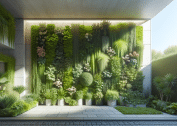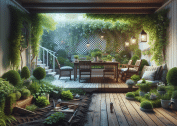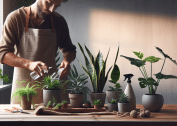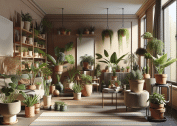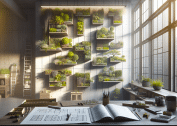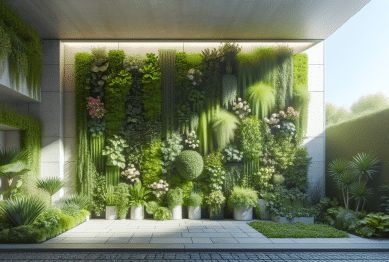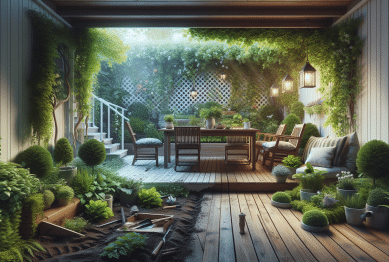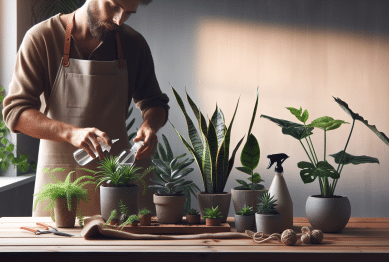Unlock the potential of your space with the wonders of container gardening. This guide reveals smart plant choices, essential soil tips, and maintenance advice, making it easy for anyone to cultivate thriving greenery indoors or outdoors. Explore how versatile pots, creative arrangements, and sustainable practices can elevate any home or balcony.
Why Container Gardening Appeals to So Many
Container gardening resonates with gardeners and beginners for its flexibility and accessibility, making it a popular trend in both urban and rural settings. Whether faced with limited space or craving a more organized look, containers provide endless possibilities to arrange herbs, flowers, and vegetables on patios, balconies, or window sills. The appeal stretches beyond just the variety—there’s convenience in being able to move pots to adjust for sunlight or protection from weather. Compared to traditional beds, container gardening allows control over soil quality and drainage, contributing to enthusiastic adoption in modern homes. Communities with smaller outdoor spaces often turn to containers for maximizing greenery while retaining aesthetic appeal and functionality.
Another striking benefit is how container gardens can travel indoors during cold months or harsher climates. This portability opens up choices from tropical plants to delicate annuals that wouldn’t otherwise survive year-round outside. Even novice growers see fast results, since potting soil in containers tends to warm faster and support quicker seed germination. Many households have found that compact spaces become instantly vibrant with colorful foliage and seasonal blooms, uplifting mood and air quality indoors. The enhanced sense of control also means plant lovers can experiment freely with combinations, patterns, and pot styles.
The adaptability of container gardening attracts those wanting to customize their green oasis. People appreciate the ease of integrating edible plants—think tomatoes, peppers, or strawberries—next to ornamentals, yielding both beauty and fresh produce just steps from the kitchen. This method also assists those with mobility issues, as pots can be raised or wheeled. In short, container gardening combines style, practicality, and well-being for plant enthusiasts and newcomers alike, turning any corner into a blooming sanctuary. Explore how this trend is shaping even the smallest spaces into lush, personalized retreats (https://www.almanac.com/container-gardening-101).
Choosing the Right Containers for Your Space
Selecting suitable containers is crucial for achieving healthy growth in any gardening project. Each type—ceramic, plastic, metal, or terracotta—offers unique advantages. Ceramic and terracotta pots promote natural airflow to plant roots, reducing the risk of water stagnation. Plastic pots, on the other hand, are lightweight and retain moisture, which is helpful in sunny settings or for drought-tolerant species. For those focusing on aesthetics, decorative baskets or colorful glazed pots can complement interiors or outdoor decor. When choosing, prioritize drainage holes, as excess water often leads to root rot. Matching pot size with plant type is also essential, ensuring comfort for root systems without overwhelming seedlings or stunting growth.
Bigger isn’t always better—oversized containers might retain too much water and cause instability for upright plants. Meanwhile, small pots heat up rapidly, which can be stressful for shallow-rooted varieties during peak summer. Some gardeners recycle old buckets, wooden crates, or even fabric grow bags for sustainability, offering both charm and function. Choosing lightweight materials is ideal for those wanting to rearrange their setup, while more permanent displays may benefit from sturdy, frost-resistant options. Ultimately, the container’s look and feel should harmonize with its plant’s needs, space constraints, and personal taste. Experienced gardeners recommend experimenting with heights, shapes, and textures to create striking multi-level arrangements.
Another key point in choosing containers is their compatibility with self-watering systems. Such systems save time and ensure consistent moisture for busy individuals. If selecting pots without these features, consider adding a layer of gravel at the bottom to enhance drainage. Many urban gardeners create vertical gardens with wall-mounted or railing planters for added dimension. Where pets or children are present, avoid heavy or sharp-edged pots for safety. For eco-conscious growers, containers made from recycled materials help reduce environmental impact while maintaining vibrant plant displays. As gardening technologies advance, a wider selection of containers continues to inspire creativity and adaptation for all spaces and climates.
Potting Mix and Soil Health Essentials
Soil selection is foundational for container gardening success. Unlike garden beds, pots demand special attention to drainage, aeration, and nutrient content. Standard garden soil is too dense, often leading to compacted or poorly draining roots. Opting for a high-quality potting mix—usually a blend of peat, perlite, and vermiculite—creates the ideal balance for sustained growth. Adding compost or slow-release fertilizer supports robust plant development while encouraging beneficial microbial activity. For those looking to grow edibles or sensitive species, consider organic potting mixes free from synthetic chemicals. Amending soil annually helps replenish nutrients lost to watering and supports ongoing abundance. A little investment in quality mix sets the stage for strong plants.
Water retention is another factor, especially in hot or dry climates. Adding coconut coir or moisture crystals to the mix helps stabilize moisture levels, reducing stress on plants when outdoor temperatures soar. Well-aerated soil also warms quickly in spring, stimulating faster root establishment in seedlings and transplants. For heavy feeders, supplementing with worm castings or liquid feed midseason maintains steady growth and flower or vegetable production. Many find regular top-dressing, such as a layer of mulch or shredded bark, protects against evaporation and regulates soil temperature. Over time, observation reveals which amendments suit each plant species best, allowing tailored, successful results for all container environments.
Soil health extends beyond the mix—it includes monitoring for disease, pests, and ongoing fertility. Container-grown plants may show early signs of nutrient deficiency, like pale leaves or slow growth, making prompt intervention easier. If reusing old soil, sterilize it by baking or solarizing to prevent transfer of pathogens. Rotating crops within pots each season helps minimize the buildup of soil-borne diseases and pests. Some gardeners use beneficial nematodes or biological products to keep pest populations in check. Ultimately, diligent soil care leads to more vibrant, longer-lasting plants, rewarding gardeners with healthy harvests and resilient blooms throughout the year (https://extension.umn.edu/planting-and-growing-guides/container-gardening).
Ideal Plants for Pots and Small Spaces
Choosing plants that naturally thrive in confined environments is central to successful container gardening. Many classic herbs—basil, sage, rosemary—are compact, high-yield, and require minimal maintenance. For visual interest, trailing plants like ivy or ornamental sweet potato create lush cascades from elevated pots or window boxes. Compact varieties of tomatoes, peppers, and salad greens offer continuous fresh produce, even for those without access to a yard. Shade lovers such as ferns or hostas do well indoors or on north-facing balconies. If color is the goal, try a mix of annuals like petunias, marigolds, and impatiens which put on dazzling displays with the right feeding and sunlight.
Flowering bulbs—dwarf daffodils, tulips, or crocuses—perform beautifully in deep pots, creating striking, ever-changing scenes from spring to fall. Succulents and cacti appeal to new gardeners, demanding little water or intervention. For those wishing to support local pollinators, native wildflowers or miniature lavender attract bees and butterflies. Climbing varieties, such as dwarf morning glories, can be trained up trellises or garden walls, maximizing vertical potential. Many homeowners rotate displays by season; early spring bulbs give way to summer blooms, which are then swapped for autumnal foliage or evergreens during colder months. This rotation helps maintain vibrant, continually evolving outdoor spaces.
Edible options remain in high demand. Strawberries trailing from hanging baskets, compact blueberries, or patio cucumbers are all attainable with the right potting method and support. For an exotic feel, try dwarf citrus or fig trees—nurtured indoors through winter and brought outside in warm months. When space is limited, combining edibles and ornamentals in the same pot—known as edible landscaping—maximizes output and interest. For best results, group plants by water and sunlight needs. This synergy creates harmonious displays, minimizes care requirements, and supports robust, healthy growth season after season (https://hort.extension.wisc.edu/articles/container-gardens).
Watering, Feeding, and Care Routine
Achieving vibrant growth relies on a consistent care schedule, especially in the fluctuating conditions typical of potted plants. Watering is perhaps the most crucial aspect—pots dry out faster than garden beds, so frequent checks are essential. Rather than sticking to a rigid watering timetable, it helps to check soil moisture with a finger or small meter. Early morning or late evening watering conserves moisture, minimizes leaf burn, and prevents fungal issues. Fertilizing also differs in containers; nutrients leach out rapidly, so a balanced liquid feed every 2–4 weeks keeps most ornamentals and vegetables productive throughout the growing season. Over time, attentive routines reveal each plant’s unique hydration and feeding requirements.
Extra care may be required during hot spells, especially on balconies receiving afternoon sun. Moving pots into shade temporarily or using drip trays prevents roots from overheating or drying out. Special slow-release fertilizers can reduce the feeding workload and help avoid over-fertilizing, which often causes salt buildup and stunted growth. Periodically flushing the soil with plain water also keeps roots healthy and salt-free. Grooming dead leaves and spent blooms encourages new growth and maintains a tidy appearance, while regular checks for aphids or spider mites help catch infestations early. Integrated pest management, like rinsing plants with water or introducing beneficial insects, offers eco-friendly solutions.
Long-term care routines also involve repotting every 1–2 years to relieve root crowding and refresh depleted mix. Choose a slightly larger container each time, and trim roots if necessary. In regions with cold winters, prepare to bring tender plants indoors, checking for pests and acclimating them gradually to avoid shock. For year-round color, swap in cool-season annuals as summer performers fade. Over time, simple, mindful routines not only sustain plant health, but also let gardeners enjoy a rolling display of greenery and blooms at every stage of the year (https://extension.psu.edu/growing-plants-in-containers).
Creative Arrangement and Design Tips
Artistry blends seamlessly with practicality in container gardening. Color, height, and texture work together to create stylish arrangements. Try grouping containers in odd numbers, varying the heights to generate visual rhythm. Planting a thriller (a focal point), a filler (lush foliage), and a spiller (trailing variety) in one pot is a classic design technique. Color schemes—contrasting, monochromatic, or complementary—unite the display, reflecting personal taste or seasonal moods. Experimenting with unexpected container shapes—boots, teapots, or vintage tins—introduces personality into the space and sparks joy in everyday settings.
For small spaces, vertical gardening brings drama with minimal footprint—stacked pots, wall planters, or hanging baskets can transform dull corners into vibrant tapestries of green. Combining edible and decorative plants blurs the boundary between function and beauty, granting new freedom in design. Repeating certain species or colors throughout the area delivers a sense of cohesion. Lighting also plays a role: highlighting key features with solar path lights or fairy string lights allows container displays to glow after dusk. Many find that regular rearranging keeps interest alive and reflects changes in plant growth and seasonal updates.
Accessibility is just as important as appearance. Ensuring easy access for watering, feeding, and moving pots prevents neglect and encourages regular interaction. For those with mobility challenges, consider elevated stands or wheeled platforms. Integrating small statues, decorative stones, or even water features adds depth and interest. In shared spaces, markers or decorative labels help guests and family enjoy learning about different plant varieties. Every container garden is an evolving canvas, open to new ideas and endless creativity. The possibilities truly are limitless. (https://extension.uga.edu/publications/detail.html?number=B1318)
References
1. The Old Farmer’s Almanac. (n.d.). Container Gardening 101. Retrieved from https://www.almanac.com/container-gardening-101
2. University of Minnesota Extension. (n.d.). Container gardening. Retrieved from https://extension.umn.edu/planting-and-growing-guides/container-gardening
3. University of Wisconsin-Madison Extension. (n.d.). Container Gardens. Retrieved from https://hort.extension.wisc.edu/articles/container-gardens
4. Penn State Extension. (n.d.). Growing plants in containers. Retrieved from https://extension.psu.edu/growing-plants-in-containers
5. University of Georgia Extension. (n.d.). Growing Vegetables in Containers. Retrieved from https://extension.uga.edu/publications/detail.html?number=B1318
6. Oregon State University Extension. (n.d.). Container Gardening Basics. Retrieved from https://extension.oregonstate.edu/gardening/techniques/container-gardening-basics


